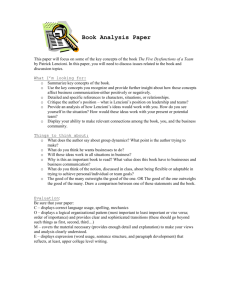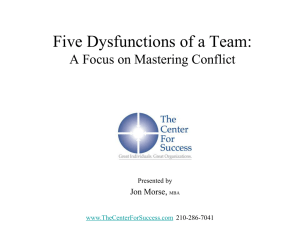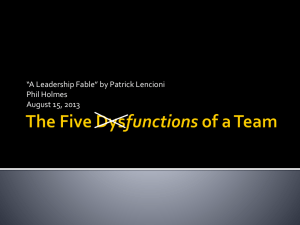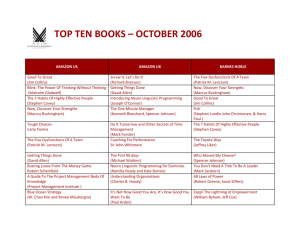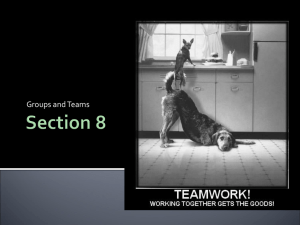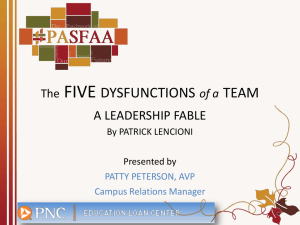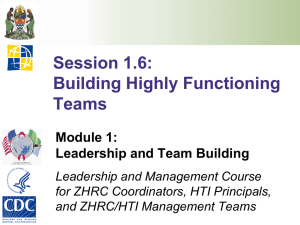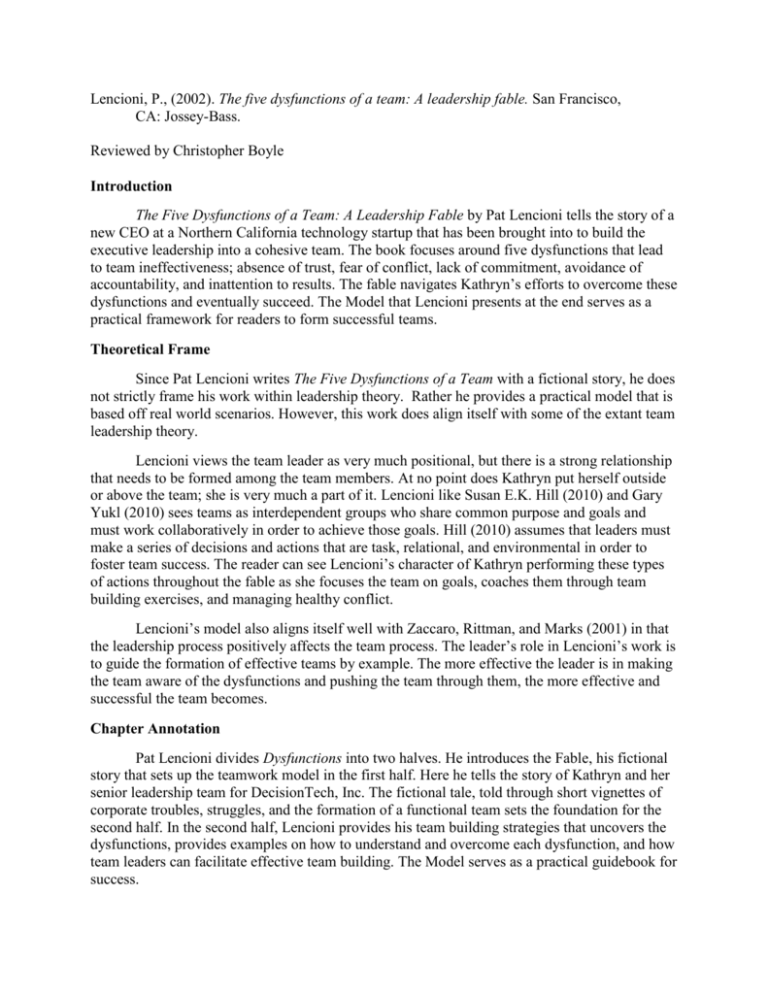
Lencioni, P., (2002). The five dysfunctions of a team: A leadership fable. San Francisco,
CA: Jossey-Bass.
Reviewed by Christopher Boyle
Introduction
The Five Dysfunctions of a Team: A Leadership Fable by Pat Lencioni tells the story of a
new CEO at a Northern California technology startup that has been brought into to build the
executive leadership into a cohesive team. The book focuses around five dysfunctions that lead
to team ineffectiveness; absence of trust, fear of conflict, lack of commitment, avoidance of
accountability, and inattention to results. The fable navigates Kathryn’s efforts to overcome these
dysfunctions and eventually succeed. The Model that Lencioni presents at the end serves as a
practical framework for readers to form successful teams.
Theoretical Frame
Since Pat Lencioni writes The Five Dysfunctions of a Team with a fictional story, he does
not strictly frame his work within leadership theory. Rather he provides a practical model that is
based off real world scenarios. However, this work does align itself with some of the extant team
leadership theory.
Lencioni views the team leader as very much positional, but there is a strong relationship
that needs to be formed among the team members. At no point does Kathryn put herself outside
or above the team; she is very much a part of it. Lencioni like Susan E.K. Hill (2010) and Gary
Yukl (2010) sees teams as interdependent groups who share common purpose and goals and
must work collaboratively in order to achieve those goals. Hill (2010) assumes that leaders must
make a series of decisions and actions that are task, relational, and environmental in order to
foster team success. The reader can see Lencioni’s character of Kathryn performing these types
of actions throughout the fable as she focuses the team on goals, coaches them through team
building exercises, and managing healthy conflict.
Lencioni’s model also aligns itself well with Zaccaro, Rittman, and Marks (2001) in that
the leadership process positively affects the team process. The leader’s role in Lencioni’s work is
to guide the formation of effective teams by example. The more effective the leader is in making
the team aware of the dysfunctions and pushing the team through them, the more effective and
successful the team becomes.
Chapter Annotation
Pat Lencioni divides Dysfunctions into two halves. He introduces the Fable, his fictional
story that sets up the teamwork model in the first half. Here he tells the story of Kathryn and her
senior leadership team for DecisionTech, Inc. The fictional tale, told through short vignettes of
corporate troubles, struggles, and the formation of a functional team sets the foundation for the
second half. In the second half, Lencioni provides his team building strategies that uncovers the
dysfunctions, provides examples on how to understand and overcome each dysfunction, and how
team leaders can facilitate effective team building. The Model serves as a practical guidebook for
success.
The Fable begins in Part One aptly titled Under-achievement where Lencioni introduces
us to DecisionTech, a two-year old Silicon Valley technology start-up company. DecisionTech,
while successful, has been struggling with morale issues, slowing business, lack of new
customers, and the recent departure of the CEO, Jeff. Enter Kathryn, a surprising and
questionable choice for a replacement with little technology experience, but capable leadership
skills.
Kathryn meets her team of senior leadership members of the company, but the problem is
they do not act like a team. There is undeniable tension between the members, but nothing is
done about it, and worse, the leadership team is slow to make business decisions. Jeff, as the
former CEO, leads business development, but rarely gets anything done. Mikey, as the marketing
director, while talented in her work is disliked by her coworkers. Martin serves as the Chief
Technologist, helped to found DecisionTech, but rarely participates in the decision making
process. J.R. leads the sales department, agrees with everyone, but rarely follows through with
his work. Carlos serves as the customer support specialist, he is the most constructive of the
group, but has an underdeveloped role. Jan serves as the CFO, has an eye for detail, and does not
let finances get out of control. Lastly, there is Nick, the CO, who is the best qualified member of
the team, but his job is limited since the company work is sputtering. The task that Kathryn has
in front of her is difficult at best.
Part Two begins with Kathryn’s observations of the new team she inherits, and it is
obvious that the team is broken and must be fixed. Lencioni writes, as Kathryn, explaining that
teams sometimes need to be broken in order to be brought back stronger. Kathryn then sets off
on a team building off-site in order to uncover the five dysfunctions and work with her team to
identify and overcome them.
Lencioni utilizes the next chapters of Part Two to establish the five dysfunctions, not in
order of importance, but rather in how they become apparent through the story. The ground rules
for the company are to make results, but the team dysfunctions get in the way. The chapter The
Speech lays out the first dysfunction, “absence of trust” without which teams cannot form nor
achieve their results. Kathryn’s team is at first skeptical, and it is clear that many of the team do
not trust Kathryn let alone each other (p.43).
Lack of trust is caused by invulnerability, the team’s unwillingness to show weakness in
front of others, take risks, and be vulnerable about their mistakes. Lencioni has Kathryn explain
how to build trust, “the only way to do that is to overcome our need for invulnerability” (p.63).
Without this genuine openness, teams will not have strong foundation of trust or trustworthy
interactions.
The chapter Ego describes the pinnacle of the five-dysfunction pyramid, which is
“inattention to results”. Inattention to results occurs when members of the team seek individual
recognition and goals at the expensive of the collective goals of the team (p. 72). Ego and status
greater than others can lead to team members focusing on their accomplishments instead of the
common purpose. The story gives the reader the example of an athletic team Kathryn’s husband
coaches. When an individual player only looks out for himself he may do well, but the team still
loses because he was not focused on team goals. Goals therefore need to be clear and achievable,
so no one member of the team would consider not focusing on them.
In Exhibition, the reader is brought back to the bottom of the dysfunctions pyramid in
order for Kathryn to address the next team function that builds off of trust, “fear of conflict”. The
false positive that results from non-conflict is “artificially harmony” where the team pretends to
come to conclusions when in reality they are not expressing their opinions (p.92). Inability to
conflict constructively is an issue because it does not allow for team members to work through
disagreement.
Exhibition also rounds out the third and fourth dysfunction that Lencioni develops
through his story. “Lack of commitment” occurs when there is no buy-in from the team
members. In the story, Kathryn provides the evidence of this through ambiguity over plans,
decisions, and goals. Although she points out that commitment does not mean consensus. It is
more a matter of having a voice and buy in rather than always being in agreement. The character
of JR refers to this as “disagree and commit” (p. 95), where members can disagree over aspects
of a project, but still be committed to the overall goals.
The fourth dysfunction is explained at the end of Exhibition. “Avoidance of
accountability” is caused by team members who do hold each other responsible for their actions
and work even after they have achieved buy-in and commitment (p. 97). When teams set low
standards for one another they are less likely to be accountable. However, when teams set high
standards, teams are more willing to make sure each member helps to reach those benchmarks.
Application continues the story with the team firmly established with the foundations of
the five dysfunctions. Kathryn attempts to apply what the team has learned for the rest of the offsite. The team comes up with the overarching goal that they will work toward for the rest of the
year: gaining eighteen new customers. This task will test the progress that Kathryn made over the
course of the previous chapters, but as teamwork goes, it is not always easy the first time.
Part Three of The Five Dysfunctions of a Team explains the trials and tribulations the
team faces as they attempt to work their way through the five dysfunctions. However, the road is
not smooth. In On-Site the progress that appeared to happen during the off-site appears to vanish.
Nick seems to be frustrated with his lack of responsibility, JR abruptly quits returning to a
previous job where he felt better suited, and Kathryn hears that some members of her team have
been confiding in their departments the on-goings of the team-building exercises.
Off-Site Number Two brings the team back to their off-site executive team building.
Kathryn explains to her that they need to remember their priorities in the office. The collective
focus on common and purpose and putting team results ahead of everything else means that the
executive team needs to be the “first team” (p. 137). If they never learn to work together, it does
not matter how effectively each executive runs their own department.
As the work plows on and the team begins to work more toward attaining their goals, it
becomes apparent to Kathryn that one executive cannot be a part of the team anymore, because
she has not become a true team member. Mikey feels that she does not need to commit to the
other team members, and fails at each of the pitfalls of the dysfunctions. Kathryn chooses to let
Mikey go because the team will not be successful with her in it.
Heavy Lifting proves to be the climax of Lencioni’s corporate fable. In response to
Mikey’s firing, Kathryn builds ultimate trust in her team by being vulnerable herself to prove her
point. She tells her own story how as a graduate student intern she worked as the head of the
financial analysis department. She promoted one of the company’s best workers, but least
tolerable employee because he could get work done. In response, half of her office quit in
disgust, production dropped, and Kathryn was fired. The purpose of the story she tells is to
explain to the executives that team members need to be able to modify their behavior to satisfy
the team. When Mikey could not do that, she had to go.
Part Four serves as the denouement of the story. At the last off-site Kathryn goes over
the model of dysfunctions one last time and asks the team to report on how they are faring. Even
though the executives have improved dramatically, Kathryn continues to push them because she
does not want to see the team slide backwards.
Gut Check introduces a new team member, Joseph, the new VP for Marketing. He is
introduces into a vibrant group that trusts one another, is committed to each other, the team, and
the company, and had the ability to vibrantly discuss whether they should be bought out by
another company. Each team members takes the time to update Joseph on the importance of
steering clear of the five dysfunctions.
The March is the final chapter of the story, and shows how the team has evolved. Since
the company has grown, the executive team shuffles around. Carlos would report to Nick instead
of Kathryn, and Jeff decided to demote himself and report to Nick as well. Although not the
same executive team anymore, they still have the ability to get to work and move forward.
Lencioni decides to reserve the second half of The Five Dysfunctions of a Team to
explain the model in more detail. He explains it as “a clear, concise, and practical guide” to
improve any team (p. 184). He provides an overview of the model in order, in a way the Fable
did not. He posits that the five dysfunctions are interrelated and should not be addressed as
independent ideas. The majority of this half is dedicated to understanding the five dysfunctions,
establishing strategies to overcome them, how they connect to one another, and explaining the
role of the team leader within each dysfunction.
He follows up with a team assessment which helps teams evaluate their susceptibility to
the five dysfunctions. Lencioni encourages team members to take this assessment before trying
to tackle the issues. In this way, teams can better understand where they stand currently, what
dysfunctions they need to focus on more, and what implications this would have for the team.
Trust is the foundation because no team can function without it; morale is low and teams
cannot focus on their work. Lencioni suggests that teams try practical exercises to build trust.
These include personal histories, so team members learn about one another; team strengths and
weaknesses, feedback exercises, or Myers-Briggs Type Indicator profiles. The role of the leader
in this first stage is to set the example, and be the first to show vulnerability (p. 195-201).
Conflict needs to be ideological in nature, and focus on concepts, ideas, and direction. It
must also be productive and passionate. Lencioni suggests that teams should not fear conflict
because they might hurt others because if they trust one another they will not. Teams can
overcome fear of conflict by mining conflict and push discussion forward. Leaders at this stage
must let productive conflict happen, and be a model for how to present this behavior (p. 202206).
Commitment must have both clarity of decisions and buy-in from each team member for
it to be successful. Lencioni warns that consensus and need for certainty are the pitfalls that
signal a false sense of commitment. He proposes that teams utilize tools such as “cascading
messaging”; deciding what information must be passed along to subordinates allows team
members to be clear on decisions (p. 210). Leaders must be comfortable making tough decisions,
and cannot be afraid to make be wrong. They must also continue to push for closure and dissuade
consensus (p. 207-212).
Accountability is significant to Lencioni because it builds and strengthens relationships
between team members. This allows team members to have high expectations, and be more
willing to call out others when they are not operating at that level. Lencioni suggests that teams
create a list of standards that each member will adhere, institute progress reviews, and have team
rewards. The leader at this stage must help to create a “culture of accountability” to ensure
responsibility (p. 216). Teams will have a tendency to focus on their own needs if they are not
focusing on what the team should be accomplishing (p. 212-216).
Attention to results is the pinnacle of the model. Teams need to set aside their individual
agendas and focus on team goals and results. Focusing on own status and position can be
negative to the whole team. Lencioni suggests that team set a “declaration of results” that lays
out everything the team wants to accomplish and stick to (p. 219). Leaders at this stage must
exemplify this stage and be totally objective in their work and observations (p. 216-220).
Target Audience
The Five Dysfunctions of a Team is written for a business and management audience
primarily, but the lessons learned from the fable and the model Lencioni presents is applicable
and adaptable to many audiences and disciplines. Lencioni himself is from a managerial
background, and has written three other books about corporate leadership, so it is appropriate
that this book comes from that perspective. However, The Five Dysfunctions of a Team would be
beneficial for any leader or a team member in an environment that works with teams, especially
college students. The lessons and actionable model that result from the fable is helpful to anyone.
The examples he uses and the flow of the story is easy to pick up. He does not lose the reader in
heavy business details or unfamiliar language of the corporate world, so it is easily relatable.
Use for Book in Practice
Pat Lencioni’s book is very practical. In fact, he prefaces the model by explaining that
readers can use this as a guide to improve their own teams. This work can easily be used for a
student leadership program for many reasons. Since it aligns itself well with other team
leadership models, the material and recommendations will be very familiar to students and those
practitioners forming the programs.
Secondly, many student leadership development theories such as the Social Change
Model, Leadership Challenge, and Relational Leadership have team work and team dynamics as
important pieces to them. Student Affairs professionals would easily recognize the significance
of a work that deals with fostering healthy team dynamics and norms. Therefore, Lencioni’s
work can be used as an additional piece to look at how teams should function to be effective.
Lastly, The Five Dysfunctions of a Team would be beneficial as a practical introduction
to how teams are formed and how they function. Unlike most leadership literature, Lencioni
focuses on what are the major elements that teams fail to do. Utilizing the practical guide will
allow leadership development programmers and students to identify weak team practices, steps
to improve team work, and ways to analyze their own team membership skills.
Critique
Pat Lencioni provides a guidebook that flows well and is easy to read. He draws the
reader into the team at DecisionTech, and makes the reader feel for the role that Kathryn is trying
to play as CEO and team-builder. In this way, it is easy to pick out the important points that he
makes regarding team leadership strategies, pitfalls for teams, and why the team process is so
significant to organizational success.
The Five Dysfunctions of a Team focuses on the negatives of team work, so that reader is
able to identify them within their own organization. The reader is able to understand through the
fable how the dysfunctions have implications in a real-world company, and how by addressing
them and overcoming them an organization can be successful. The model at the end then
synthesizes the material into a step-by-step guideline. The real-world practicality of Lencioni’s
work is the strongest aspect of this book.
The model that Lencioni presents is very practical and user-friendly. He provides
examples of poor and strong performing teams within each stage. Moreover, he lists activities
and strategies that teams can use in order to break through a particular dysfunction; everything
from personal histories to gain trust to setting goals and standards for accountability. At the very
end, Lencioni provides Kathryn’s management style as an example for how much time teams
need to spend together to get real work done.
While Lencioni’s story is fictional, his model is pulled from his own experiences as a
team leader and manager. However, his model does not provide the reader with any
corresponding literature or implications from other work that reinforces the points he makes. The
strongest way to analyze a piece of literature is by triangulating it with other related work.
Lencioni does not provide the reader with this information, so they can only take him at face
value.
Lencioni presents leadership as being relational, but the largest negative critique is that he
does not address how leadership is developed within his story and model. His team leader
Kathryn, at this point in this story is already an accomplished and well developed team leader.
Her primary role is the development of team members and followers. While the model presents
examples of the leader’s role in developing positive team processes, it does not detail how team
members identify themselves with leadership skips develop into future team leaders. A further
analysis by Lencioni would have been beneficial.
Since The Five Dysfunctions of a Team is a fictional account it is not based on any
empirical literature or studies that the reader is aware of. It is difficult to test his model without
any theory in which to frame it. Rather, it is only practical and anecdotal. From the book it
appears that each dysfunction carries the same weight, but in reality this may not be the case.
What is true for some teams may not be equally true for others. Without any guiding principles,
it is difficult to implement Lencioni’s model more fully.
Overall, Pat Lencioni is very successful with The Five Dysfunctions of a Team because it
is practical. While it is not a piece of empirical research, the application of his model is
beneficial nonetheless. He seeks to address team problems as they occur naturally in the working
(or collegiate) environment, and provides a useful guide for how to break through them to form
sustainable and productive teams.
References
Hill, S.E.K. (2010). Team leadership. In P. G. Northouse, Leadership: Theory and practice (pp.
241-270) (5th ed.). Thousand Oaks, CA: SAGE Publications, Inc.
Lencioni, P. (2002). The five dysfunctions of a team: A leadership fable. San Francisco, CA:
Jossey-Bass.
Yukl, G. (2010). Leadership in organizations (7th ed.). Upper Saddle River, NJ: Pearson Prentice
Hall.
Zaccaro, S. J., Rittman, A. L., & Marks, M. A. (2001). Team leadership. The Leadership
Quarterly, 12(2001), 451-483.
Reviewer
Christopher R. Boyle is a second-year Masters student in the Higher Education Administration
program at the University of Maryland, College Park. His full time job is in the Office of
Admissions and Student Services at the Johns Hopkins University School of Nursing. His
research and practice interests include encouraging student leadership and engagement, and high
impact practices in student services.
Boyle, C. (2011). The five dysfunctions of a team. [Review of the book The five dysfunctions of
a team: A leadership fable, P. Lencioni]. National Clearinghouse for Leadership Programs.
Retrieved from http://www.nclp.umd.edu

